How to Make Macarons
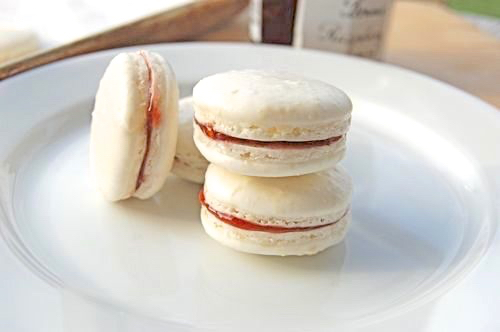
Foodies have come to revere the macaron the way Catholics do the communion wafer. Therefore it only seems fitting to open this tutorial with a prayer. As we prepare to undertake this mystery, let us acknowledge our failures and ask the Lord for pardon and strength. Amen.
Now then, to business. What I’m about to demonstrate is the classic French method for making macarons. There’s another method, called the “Italian” method because it employs Italian meringue. The French method, I think, is more straightforward if not as adaptable for incorporating exotic flavors.
Begin by arraying your ingredients. Those of you who are familiar with macarons will note that whereas most macaron recipes call for almond flour, I’m using slivered, blanched almonds. There are two reasons for this. First, because almond flour and/or meal aren’t commonly available in America, even in specialty shops. And second, even when you can find one or the other, you can never be sure how old they are. Nut oil is critical to the success of a macaron, but it can go rancid and/or solidify over time. The best way to ensure freshness is to grind your own in the food processor. As you can see above, the homemade stuff will give you a slightly knobbly texture, so if you’re really serious about macarons, order almond powder or flour or meal fresh from a good online resource. Here I have:
3.8 ounces blanched almonds
7 ounces powdered sugar
3.5 ounces egg whites (aged overnight at room temperature)
1.75 ounces granulated sugar
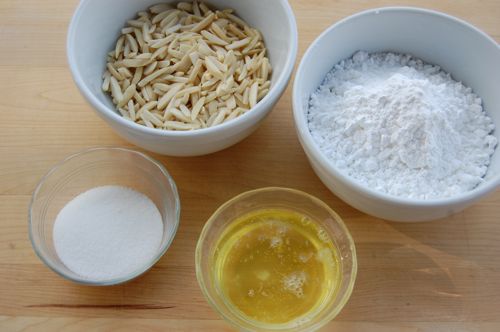
Start by grinding your almonds and powdered sugar together in a food processor. This is a good idea even if you’re using pre-ground almond meal or flour, since it’ll aerate it, mix it well with the sugar and reduce the particles to the smallest possible size.

This is about the best I can do with my machine:
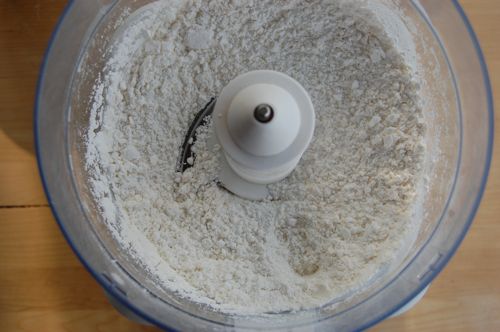
Next, prepare a pastry bag, fitting it with just the coupler, no tip.
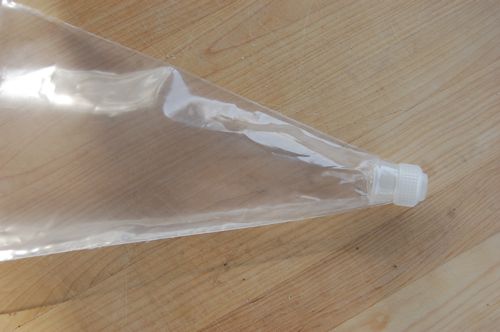
Stand it up in a tall glass for easy loading.
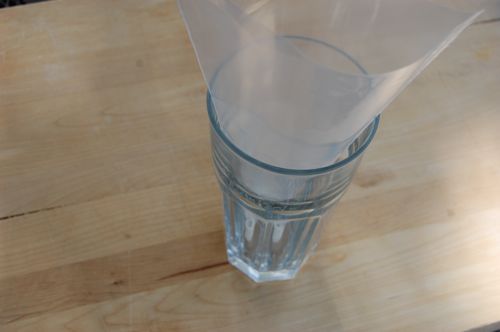
Now to make the batter. Put the egg whites in the bowl of a mixer fitted with a whip. This is a good point to add a few drops of coloring if you want to.
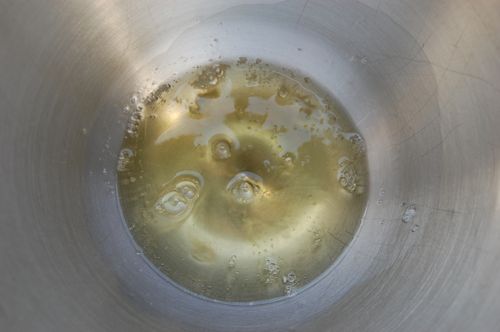
Whip to about the soft peak stage.
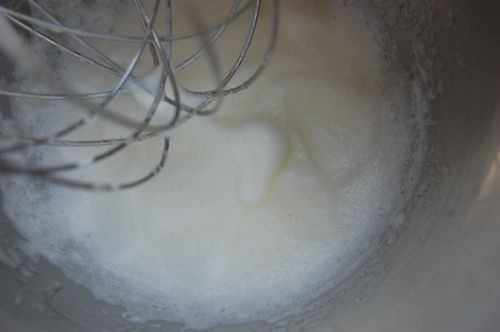
With the machine running, add the granulated sugar and whip to stiff peaks: the “bird’s beak” stage, like this:
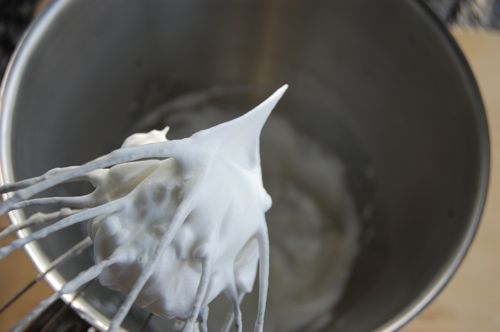
Next add your almond/sugar mixture…just dump it in.
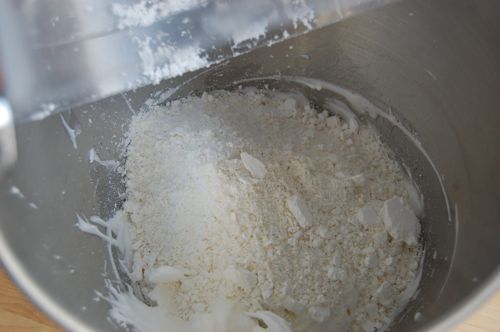
Now, without regard to consequences, stir the mixture together. Don’t fold at this point — stir. Because remember, this isn’t spongecake. Part of the point is to break some of these bubbles. If the batter’s too light it’ll dry out in the oven and crack. That’ll let the steam out and bye bye feet. So don’t be delicate, stir for maybe 30 seconds. (Be sure to scrape the sides as you go).
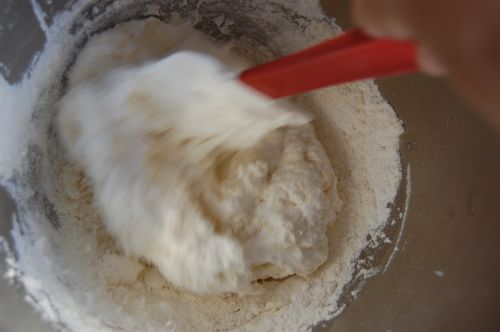
When the batter is about to this point, you want to start folding (find instructions on how to fold under the Techniques menu). Fold four or five times, then start testing the batter for readiness.
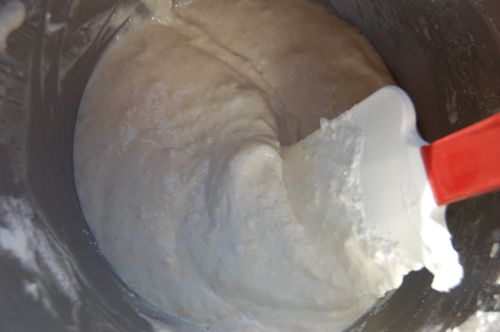
How to do that? Why, with a spoon of course. You just scoop up a small portion of the batter and plop it onto a plate or sheet pan. What you’re after is a small mass that settles down into a nice disk after a few seconds, but with a subtle peak in the center. About like this:
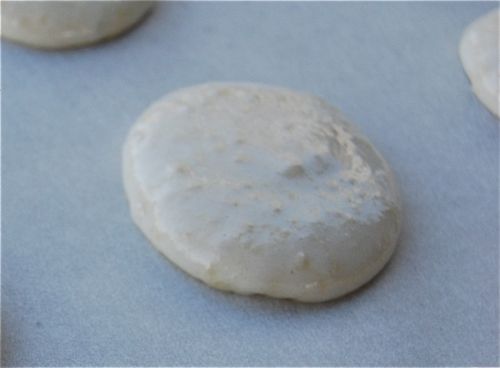
If your batter mounds up too high, go back and fold a few more times. If you over-fold a little and the batter runs a bit, that won’t be the end of the world. Contrary to what you may have heard, a few extra strokes is unlikely to ruin your macarons. The biggest mistake most people make with macaron batter is that they baby it too much. I’ve said it before and I’ll say it again: pastries can smell fear. Confidence is key.
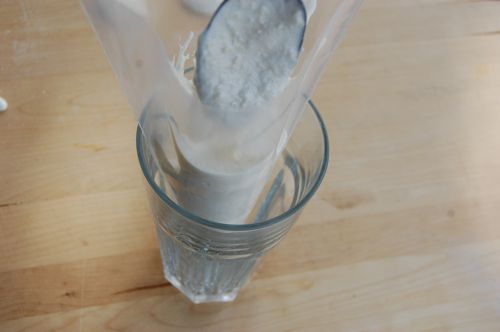
Once you’ve arrived at the right texture, spoon the batter into your pastry bag, and start piping onto a parchment-lined sheet.

You want small disks — smaller than you may imagine — only about an inch and a half in diameter. Now then, here’s perhaps the most important tip I have to pass on: let your macarons rest. For how long? About half an hour will suffice, though you can leave them up to about 50 minutes if you want. What will this do? It will allow the skins of the macarons to dry out. That will make them inflexible, constraining the rise as the macaron heats. With nowhere else to go, the expanding interior of the macaron will be forced downward, which will push the cap up, and the result will be feet. See?

You’ll want to bake your macarons on a lower-middle rack of a 300 oven (you can get it preheating while the piped macarons sit) for about twelve minutes. Let them cool for a minimum of half an hour, then gently peel the parchment off the backs.
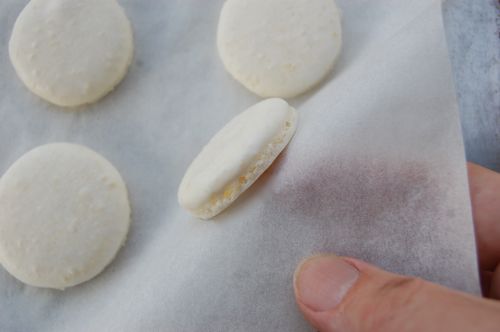
Grasping one meringue, apply the filling of your choice. Nothing exotic here, just raspberry jam. But oh, I do love it so.
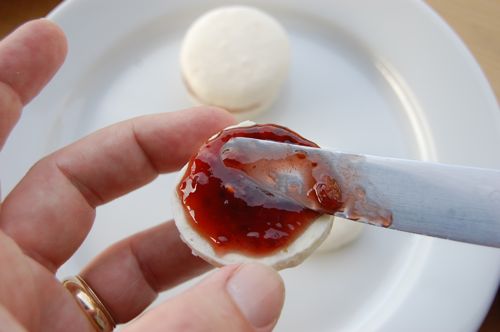
Apply the top and your task is complete. Repeat until all your sandwiches are assembled.
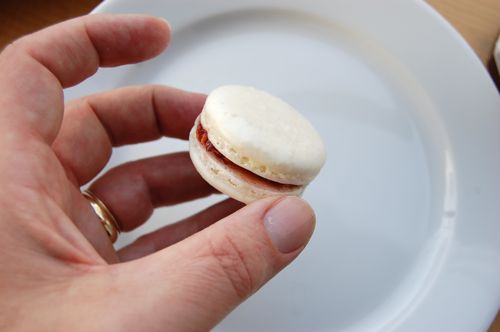
And with that, this tutorial is ended. Go in peace to love and serve the Lord, make macarons, and brag about it.
There is a store in Arizona called AJ’s Fine Foods that makes coffee, pistachio, and lavender macarons. If you have the time, I’d love to read a blog post from you that gives directions for making flavored macarons. The lavender ones were my absolute favorite. I’d be eternally grateful if you taught me how to make them.
Hey Randi Nice to hear from you. Tell me if you remember, was the filling lavender-flavored, or were the macaroons themselves lavender-flavored?
Well, the macaroons were very lightly lavender colored (the coffee and pistachio were darker in their respective colors) and they did have bits of lavender stuck to the top. They had lavender flavored buttercream on the inside, which may have been where most of the flavor came from. But, they were VERY flavorful considering the amount of buttercream that was in the middle; which wasn’t too much as most of the texture came from the meringue.
Joe,
I did see this! I cannot believe that I didn’t remember! Acutally, I printed it out and added it to my “To Bake” list! Thanks again!
Let me know how they go!
– Joe
They look really cute – great step by step photos!
We’ve tried making raspberry ones before but havent had much success with other flavours. Will have to try these.
http://www.bakingmakesthingsbetter.com
Joe dear
how have you been
my sister and I love this tutorial
as always you make everything feel understandable..
we were curious about the lavender comment…how to make lavender flavored macaron shells?
thanks for the tutorial..a real great one
Hello! Nice to hear from you again!
It’s harder to infuse macaron shells with flavors when using the French method. The Italian method (which I don’t show) calls for syrup, which requires water to make. However if you substituted some lavender tea for the water, it serves the same function as water, but adds some flavor and aroma. See what I mean?
When using a French batter, the only real way to perfume the shells would be to infuse the sugar with lavender leaves. Just as when making vanilla sugar, where you immerse a seeded vanilla bean in a jar of sugar, you’ll get a similar result by immersing lavender leaves in granulated sugar for a week or so. The flavor won’t be strong, but probably enough to notice when the macaroons are baked. Crush the leaves a little before you put them in the sugar to release their oils.
Let me know how it goes!
– Joe
since eggs whites contain some water, could you immerse the lavender leaves in the eggs whites themselves to try to infuse the egg whites with the lavender flavor? or would the eggs white then not whip up properly with the leaves mixed in?
Hey Deb! Good question. The trouble with infusions is that they require heat to really get the essential oils out of the herbs. Heating the egg whites to any significant degree will cook them. Is there any other liquid in the preparation you might be able to use?
– Joe
Wow, you are so knowledgeable Joe. I love your recommendation about infusing lavender leaves with sugar. I’m in the process of learning how to bake and your website has provided me extensive resources in doing so. Thanks for sharing your expertise!
My very great pleasure, Nancy! Please don’t hesitate to wrote in with any questions…I’ll do my best to answer them!
– Joe
Thank you for all the tips. I will soon bake my second batch of macarons and will see how they go:)
Let me know how it goes, Miss K!
– J
Hi Joe, I am hoping to finally get around to making macarons, and have a few questions before I start! About how many macarons does this recipe make? Also, how much liquid flavouring would you say I can get away with adding here? (I have some reduced sour cherry syrup that I would like to use for the filling but also in the batter if it won’t ruin them.) If I wanted chocolate batter, would it be safer to go with cocoa powder or melted chocolate? Thanks as always!
Hey Jen! I’d start off with the plain variety and make sure you get that mastered first. That said, you probably won’t be able to use the syrup unless it’s really REALLY concentrated…like an extract. Because you can’t change the proportions much without the mixture becoming too liquid. For chocolate you’ll definitely want to use cocoa powder…about three tablespoons should do the trick.
Regarding numbers, that’s a good question. It’s been a while, but this recipe should make about 3 dozen. Good luck and let me know how it goes!
– Joe
Thanks, Joe, will do! By the way, possibly a dumb question, but is the 3.5 oz of egg white fl oz or by weight? Do you recall around how many eggs that amounts to?
And in terms of filling, do you think your heritage frosting will work? I’ve had my eye on it for a while…
That’s by weight (always) and it’s two large eggs. And heritage frosting will be splendid!
– Joe
Hi Joe,
This is my 2nd attempt making macarons using your recipe.
The first batch was a disaster as I’m doing it with a few friends.
Too many cooks, spoilt the broth; indeed. The batter was too runny that I can’t pipe at all. Apparent the other “know how” friend was using an Italian recipe & according to him, we need to fold for a long period of time. A total disaster!!
Today, I did it on my own & it turned out to be ok but a few flaws.
But before that, I cleverly added a few things to your recipe.
1. I added cream of tartar, thinking it should stabilize the meringue. Not sure if it has anything to do with my “flaw”.
2. I added orange peel with a little orange juice + coloring when the meringue is soft peak
The rest I follow exactly.
Flaw 1: the meringue didnt reach peak form after i added the orange zest + a little juice + coloring.
Flaw 2: No feet – I guess I didn’t rest long enough; I rested for 30mins. Maybe I should rest longer
Flaw 3: some macarons crack after baking.
Flaw 4: wasn’t too sure what texture should a good macaron feels like. Mine turn out to be crispy on the case, as you bite into it, there a chewy texture; not melt in the mouth feel.
How would you describe the correct texture?
Had some macaron from local shop in the past but they tasted so awful that I don’t remember how they should taste, just wanted to dispose them ASAP.
Gosh, I’m really a problematic student yeah!
Jacob
Flaw
Hi Joe,
Problematic student here again. Lol
After the last attempt which I asked a lot questions.
I tried the Italian method last 2 days.
Both attempts failed miserably.
As I was reading your post again, I couldn’t agree more with the fact macarons making indeed need to start with a prayer.
I guess, just need to fail a few more times before I can really comprehend this little cookie!! What a bugger! Lol
Jacob
Sorry to hear about the frustration, Jacob! Keep after it. What was the problem my I ask?
– Joe
Joe,
The last failed batch, I was using Italian method.
It was quite pipable & the batter wasn’t too runny.
However when I baked them, no feets seem to form & I see that they looks like rose quite nicely.
However when I took them out of the oven, they collapse & it’s not cook in the middle.
I guess I was overly adventurous with the italian method which I added flavors to the almond paste. First failed attempt, I added green tea powder. 2nd failed attempt, I added blueberry jams to give the shells flavor.
Anyway, ran out of icing sugar.
Gonna attempt this bugger this weekend again, but just plain macaronage.
Hmmm, I think I should fast & pray for these little buggers. Lol
Jacob
Joe!
I cannot thank you enough for this recipe! I made these for the first time tonight and they turned out perfect!
I’ve read a lot of macaron recipes but I was afraid to try them because it all seemed so finicky. Your instructions were SPOT ON and took away my fear!
As always, you’re an awesome teacher and I’ve learnt a lot from you!
You made my day, Anna!
So glad they worked…come back!
– Joe
I’m back!
Just letting you know that I made these again but with raw blanched hazelnuts and most of them turned out great. The rest cracked but it was due to the fact that I was arsing around and not paying close attention to the batter. Oh well.
Thanks again, you are so effing awesome.
The end.
Hey Anna!
You crack me up! But I’m so glad the variation worked. Thanks for writing in with it, I know there are a lot of readers out there who’ll find that information valuable indeed. You’re awesome yourself. Even effen so.
Cheers,
– Joe
Can I substitute half the almonds with peanuts?
Hi Nate!
My feeling is not, but there’s only one way yo find out — try! Peanuts are oilier than almonds and that might throw the foam off…but I’d be curious to know what happens!
Let me know if you decide to dive in!
– Joe
I’m so glad that someone posted about substituting hazelnuts for almonds in macarons. I LOVE macarons, and have only been able to try making them twice, because of an almond allergy in my family. Using hazelnuts (even as expensive as they are) will allow me to actually get in the practice to perfect this technique!
It’s a neat idea isn’t it? God love the internet!
– Joe
Tried the recipe and they turned out great, nice smooth tops, feet, the whole bit. One issue however. The batter was too thin, ran out of the piping bag. I noticed this during testing but additional folding had no affect. What should I have done? (They spread too much when squeezed onto baking sheet).
Thanks,
jackl
Hey Jack!
The batter is a little soupy, that’s normal. If the macarons turned out that well it means you’re going it right! Way to go!
– Joe
Hi 🙂
Just wondering, why do we use both icing sugar and granulated sugar?
Thanks 😀
Hey L!
Good question! The granulated sugar takes longer to dissolve because the crystals are a lot bigger, so that’s why they go in early with the whites. As they whip they dissolve into syrup. The powdered sugar goes in last and is only folded briefly because it doesn’t take very long to dissolve. Does that make sense?
Cheers and thanks for an excellent question!
– Joe
Thanks, that’s very useful, but why can’t we just use icing sugar on its own? Is granulated sugar necessary? Or could we substitute all the icing sugar with granulated sugar?
Glad to help L! I confess I’m not completely sure if using all icing sugar will effect the performance of the batter. However it will add extra cornstarch (since icing sugar is 3% cornstarch) and that may add a starchy taste to the finished product. It’s worth a shot, however. If you try it please get back to me with the results!
Cheers,
– joe
I just got done making these and they are now taking their counter nap.
My batter was quite runny also. Only things I did different was add an 1/8 of a teaspoon of lemon flavoring and about 6 drops of food coloring. Was it runny because I did not fold it enough? Or is it just because I didn’t do the special macaron dance?
Since it was so runny piping was a pain so instead I used a teaspoon – a heaping was perfect for the 1 1/2″ circle – to portion out my cookies. They aren’t perfectly round but figured for a first try what the heck.
Thanks for your awesome show & tells!!
🙂
H
Interesting, Holly. I hope they worked out OK in the end. A lot of things could have affected the batter, from flavor and color to humidity. Folding probably had little to do with it, unless you folded a whole lot. If the eggs were whipped nice and stiff to begin with then you’re doing it right. Perhaps add a little more almond next time to give the batter more body. Way to go in tackling some difficult cookies!
Cheers,
– joe
Hi Joe! I’ve been turning to your website more and more lately and have been really loving all your insights into pastry – you’ve answered a lot of my unending questions 🙂 I quit my job as a Chartered Accountant about a year and a half ago to move to Paris to attend pastry school so while I’ve always been an avid home baker, I have just begun my journey as a professional. I was wondering why you use 7oz of powdered sugar to 3.8oz of almonds in the macarons. The recipes I’ve seen in France tend to use “tant pour tant” or a mixture of 50/50 powdered sugar and almond powder? Thanks again for all the insights and keep up the great work!
Hey Genia,
Thank you and congratulations on the career change! Very exciting indeed. I’d love to be a fly on the wall for some of your lessons.
Regarding your specific question, I simply find the meringue to be more stable that way. That’s better for a food blog like this where people might be trying these for the first time. Otherwise there’s no particular reason! Please keep me advised of your progress through school and let me know where you end up — I’ll be curious!
– Joe
Thanks, Joe! I’ll be sure to keep you posted 🙂
Dear Joe, i need to add cocoa powder to my recipe? but with what proportion should i add it in? decrease almond flour??
Dear Joe,
May I get some advice on how I could make some macarons more toward the savory/sweet side. Could I use mushroom powders, veg powders, or perhaps something sweet and spicy? I could use some advice and/or suggestions.
Thank You,
Ralph Perrotti
Fascinating idea, Ralph. It’s not the almond flour that’s the problem since as you point out there are any number of savory alternatives. The nut flour is just bulk, so you can use just about anything. The problem is the sugar, which dissolves into a syrup when it meets the egg whites, reinforcing the bubbles and giving the batter some body.
To replace it (or some of it) you’ll need some sort of gelling agent…gelatin, or possibly a no-heat thickening starch like agar. As for how much, that’ll take some trial and error.
You’ll need to add the gelling agent directly to the egg whites instead of folding them in, just as the eggs get foamy, that’s the time. Add the other flour, or a combo of almond flour and…whatever…that’s what I suggest to start out. Consider the alternate powder the “sugar” and proceed that way. Does that make sense?
It’s going to take time, but I love the idea. Let me know how the tests go!
Cheers,
– Joe